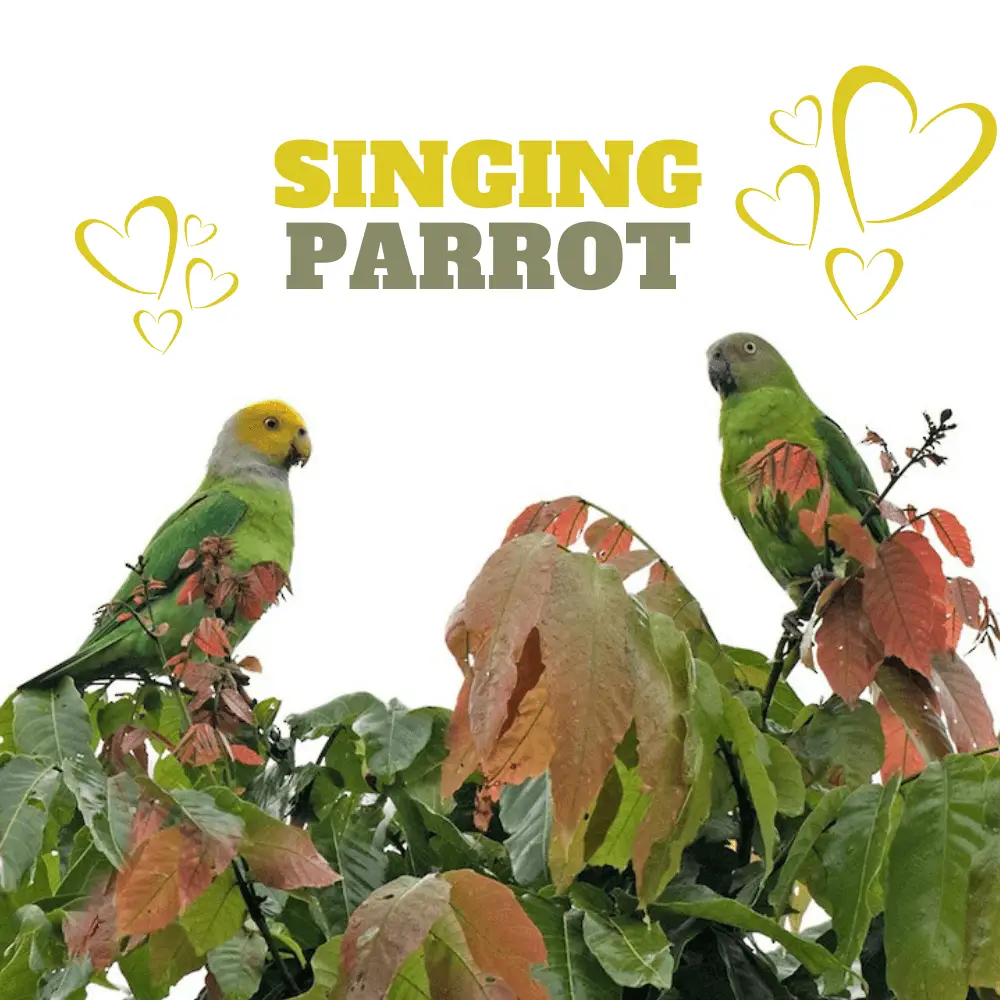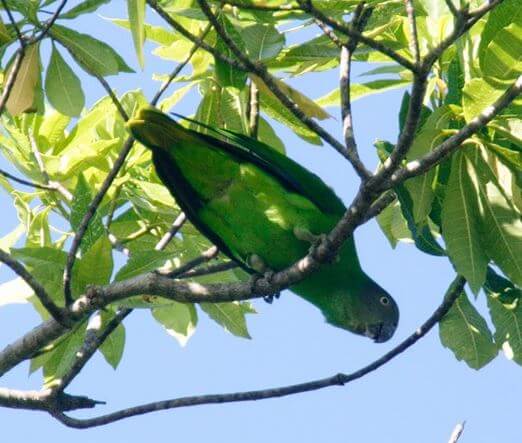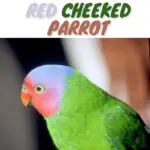
Singing Parrot (Geoffroyus heteroclitus) 24–25 cm; 150–195 g. Differs from larger male Eclectus roratus by lack of red on bill and on body sides;
in flight, when these features may not be apparent, note shorter, more pointed wings, long tails, and faster wingbeats. Compared to sympatric Lorius species, G. heteroclitus has slower wingbeats and longer tails.
Upper mandible yellow, lower grey; head yellow, brighter around forehead shading duller on the nape, and bordered by a broad, full dove-grey collar;
rest of body green, more yellowish on underparts, but with a reddish stain on median wing-coverts, deep blue on underwing-coverts, and underside of tail dusky yellow. Iris pale yellow, legs and feet greyish green.
Female has crown and face olive-grey, grey upper mandible, rest of body as in male. Immature like female but crown pale grey, and has a pale bill and dark iris.
Singing Parrot (Rennell) 24–25 cm. Previously considered conspecific with G. heteroclitus. Upper mandible yellow, lower grey; head yellow, brighter around forehead shading duller on the nape, and bordered by a very broad, full dove-grey collar that extends well down breast and onto upper mantle and hind crown;
rest of body green, more yellowish on underparts, with a reddish stain on median wing-coverts, blue on primary-coverts and wing-bend, deep blue on underwing-coverts and underside of tail dusky yellow.
Female has a crown and face deep olive-grey, grey upper mandible, rest of body as in male. Immature like female but crown paler grey.
Editor’s Note: This article requires further editing work to merge existing content into the appropriate Subspecies sections. Please bear with us while this update takes place.
Singing Parrot (Northern) Hitherto treated as conspecific with G. hyacinthinus. These two and G. simplex may form a species group. Monotypic.
Singing Parrot (Rennell) Hitherto is treated as conspecific with G. heteroclitus, but differs in its larger size, notably in tail length (effect size 8.68, score 3);
in male, much more extensive and richer lavender-blue full collar, extending onto breast; in female, grey-blue of head deeper in color and stronger on ear-coverts (1). Monotypic.
Subspecies
Singing Parrot (Northern)Geoffroyus heteroclitus heteroclitus Scientific name definitions
G. h. heteroclitus+1
Distribution
Singing Parrot (Rennell)Geoffroyus heteroclitus hyacinthinus Scientific name definitions
G. h. hyacinthinus+1
Distribution
Distribution
Singing Parrot (Northern) Bismarck Archipelago (except Admiralty Is and St Matthias Is) E to Solomons (except Rennell).
Singing Parrot (Rennell) Rennell I, in S Solomons.
Habitat
Singing Parrot (Northern) Lowland forest and edge preferred, but also uses second growth, partly cleared areas, coconut plantations, parks, and gardens up to 600 m,
although mountain overflights may be much higher and found at 900 m, Guadalcanal and San Cristobal, 1470 m in W New Britain, and 1760 m in S New Ireland.
Singing Parrot (Rennell) Presumably similar to that occupied by G. heteroclitus.
Migration Overview
Singing Parrot (Northern) No information. High flights between localities may occur on a daily basis.
Diet and Foraging
Small seedy fruit was recorded in stomachs, and also reported to feed on fruit, blossoms (e.g. Cryptocarya sp.), and buds. According to local reports, in Bougainville, both wild and cultivated (unripe) bananas Musa are staples.
Usually recorded in pairs or trios. Recorded feeding alongside Charmosyna Margaretha and Chalcopsitta cardinalis on Bougainville.
Sounds and Vocal Behavior
Singing Parrot (Northern) Very vocal, both when perched and in flight, and sometimes even sing at night. Varied musical and harsher calls (though less harsh than those of Eclectus roratus),
similar to those of other Geoffroyus, especially G. simplex, including a wavering bell-like song that commences with a soft whistle that rises or oscillates deliberately across double beats, “wuwu wowo wewe wiwi”,
also rendered “clo-clo-cle-cleo-clo-clo”, also various short, sharp calls including a shrill “chee” or “chiark-chiark”, a rapid or raucous “kyeer-kyeer-kyeer”, or musical “kee-owl-owl” or “kreel-kreel-kreel”, with emphasis on a final note
Singing Parrot (Rennell) No known differences between this species and G. heteroclitus, but poorly studied.
Breeding
Singing Parrot (Northern) Oct, but with female feeding juvenile in Aug. Nest in a hole in the dead limb of cultivated breadfruit (Artocarpus altilis); use of dead stump also recorded. Apparently excavated by females alone.
Conservation Status
Singing Parrot (Northern) Not globally threatened. CITES II. A BirdLife “restricted-range” species. Apparently now very uncommon, New Georgia, but common on New Britain in 1920s and still common in Nakanai Mts, in W of the same island, in 1990s, although it was rarely recorded at two lowland sites in E New Britain around the same period.
Locally common on Santa Isabel and Guadalcanal, and uncommon to moderately abundant, Bougainville. Highly secretive behavior may mask true abundance.

Singing Parrot (Rennell) Not globally threatened. CITES II. A BirdLife “restricted-range” species. Population is estimated crudely at 5000–20,000 individuals, but no information on trends. Highly secretive behavior may mask true abundance.





















